Garam Masala is the quintessential everyday Indian spice mix. Homemade masalas (spice mixes) offer a gorgeous array of flavors and fragrances to your meals. Here I share two family heirloom recipes – one classic, everyday garam masala, and one authentic Punjabi style garam masala – so you can stock your spice cabinet with the best blends to accentuate many of your Indian meals.
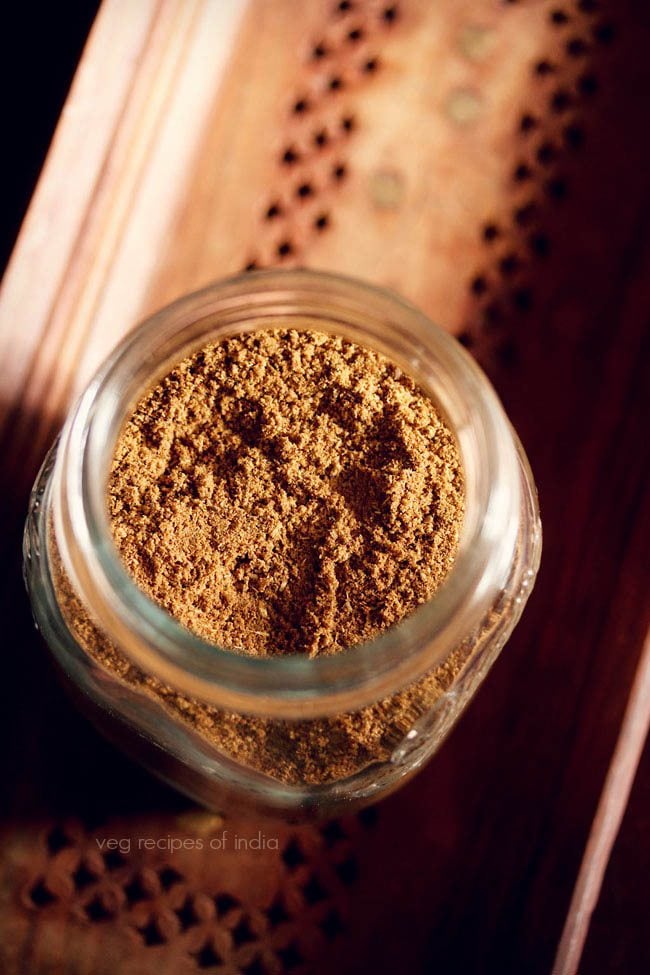
Table of Contents
- About Garam Masala
- Why This Garam Masala Recipe Works
- Ingredients You Need
- How to make Garam Masala Recipe (Stepwise Photos)
- About Punjabi Garam Masala
- How to make Punjabi Garam Masala (Stepwise Photos)
- How to use Garam Masala Powder?
- Garam Masala vs Curry Powder
- Variations
- FAQs
- Recipe Card for Garam Masala Recipe (Homemade and Authentic)
- Recipe Card for Punjabi Garam Masala
About Garam Masala
Garam Masala is an fragrant and complexly flavored spice blend. Garam is the Hindi word for “warming,” or “hot”, while the word Masala means a blend of spices. Garam masala is therefore a term that refers to a slightly spicy, warming spice blend.
Made with a mix of whole spices that are fragrant, pungent, sweet, hot and smoky – all the integral flavors of Indian cuisine! Using garam masala as a spice blend in your food not only adds aroma and flavor to your meals, but also helps to warm the body, and also acts as a digestive aid.
Garam masala is easily found in most grocery stores amongst the other spice blends, but making your own is super easy to do and makes a huge flavor difference in your cooking.
Why This Garam Masala Recipe Works
This everyday authentic garam masala has awesomely intense, fragrant flavors that will quickly improve your everyday dal, curry or sabzi. Since the masala is quite strong, I suggest adding only about ¼ – ½ teaspoon for every 4 to 5 servings in a recipe.
My homemade garam masala is gluten free and is made with easily available whole spices. The spices can be found in any well stocked Asian, Indian or international grocery store, or online.
My family’s garam masala recipe has one unique ingredient that really sets it apart from other blends – dried rose petals. They offer a delightfully floral fragrance to the blend that I really enjoy, similar to a Moroccan rose petal harissa.
However, not everybody will have easy access to dried rose petals. If you have them, then add them. If you do not, no worries! Simply omit them.
Homemade spice mixes (masalas) are the best, for so many reasons. You are in control of the ingredients that you add, they are free from preservatives and additives, and you can easily adjust them to your own flavor preferences.
Most importantly, though, making your own masalas mean you can use the best quality spices around.
Sun-Drying Or Roasting Spices
The spices can be sun-dried, oven-dried or roasted/toasted in a frying pan.
If you live in India, you will get good enough sunlight during the summers to dry whole spices. I sun-dried the spices for 2 days before grinding them to make this garam masala recipe.
You can also roast or toast the spices one by one in a pan on a low heat till fragrant and then grind them instead.
You can also heat dry the spices in an oven set at its lowest temperature. The temperature can range anywhere between 50 – 80 degrees celsius (122 – 194 degrees fahrenheit). Depending on the temperature range, you may dry them for about 6 hours to 15 hours.
This recipe yields about 190 grams of ground garam masala, but the ingredient proportions in the recipe can be easily halved or doubled depending on how much you need.
Ingredients You Need
This yummy recipe for classic, everyday garam masala requires just a dozen whole spices that you should able to find without much difficulty. Here’s everything you need:
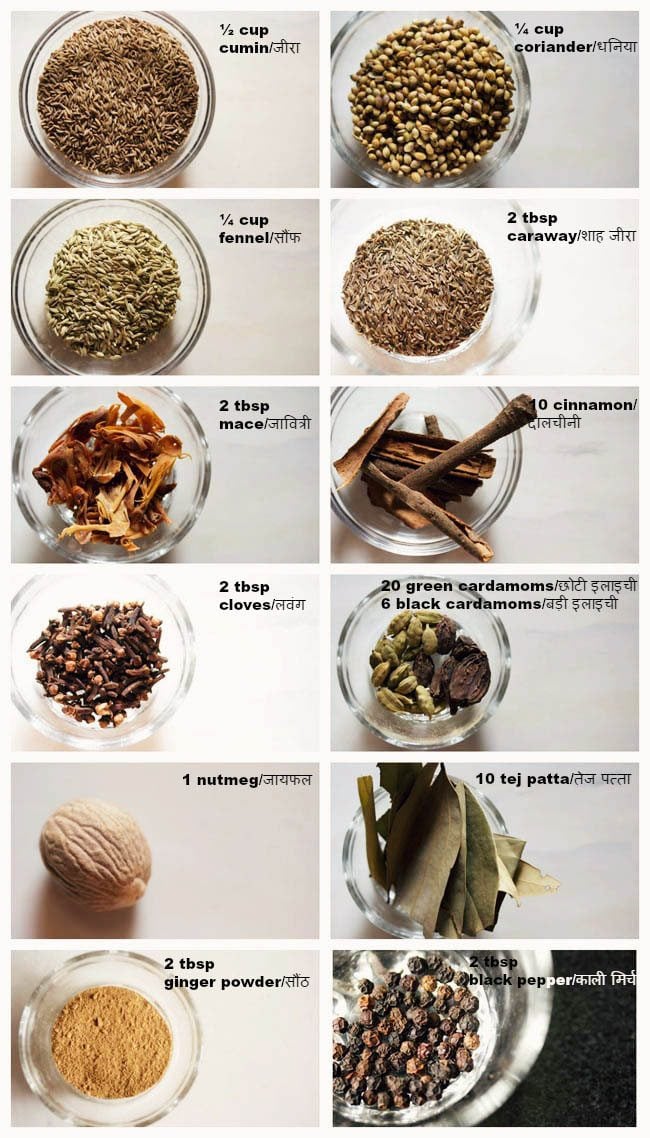
Garam masala has a rich blend of warming (e.g. ginger and cloves), sweet (e.g. fennel and cinnamon), and spicy (e.g. black peppercorn) herbs and spices. All these spices are the backbone of Indian cooking, and you’ll find them in different quantities throughout many authentic dishes.
Honestly, it is difficult to imagine Indian cuisine without these flavors! As such, it makes sense that garam masala would be such a central spice blend in the Indian kitchen.
Handy Tips
- Check all your spices to see if they have stones, chaffs or husks. Spread them out onto a plate and remove any bad bits.
- Make sure the spices don’t have any hidden mold, fungi, or insects growing on them. If they do, then discard these spices.
- Use fresh spices, not old or rancid ones.
- Sun-dry or roast/toast the spices in a pan or skillet.
- Be sure to reach for true ceylon cinnamon and not cassia; they are not one and the same, though they are often used interchangeably. But note that in a pinch you can use cassia if true cinnamon is out of your reach. Though with cassia cinnamon, the aroma and flavor will be different.
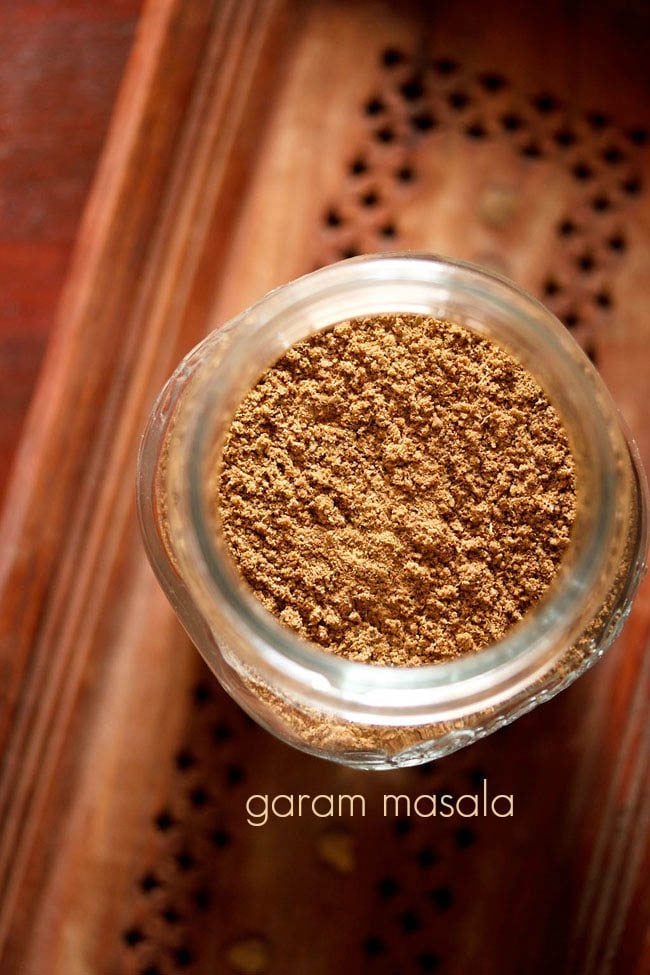
How to make Garam Masala Recipe
Prepare & Dry Spices
1. Sort through the spices to ensure they are free of stones, chaff, husks, mold or insects. Spread the whole spices on a plate or tray and keep in the sun for 2 to 3 days.
TIP: If you do not have ample sunlight, then dry roast/toast each spice separately in a skillet or pan on low heat. Stir often when roasting the spices. Roast until lightly fragrant. Do not brown the spices.
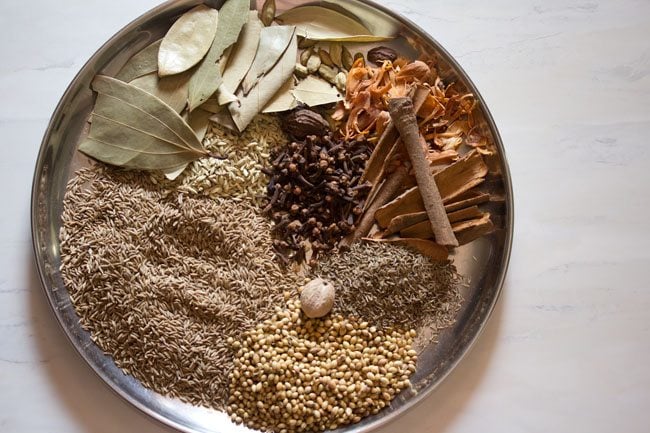
2. While sun drying, cover with a sieved lid, muslin, or a loosely woven cotton napkin so that dust does not fall on the spices.
During daytime, I keep the spices out; at night, I keep the plate inside with a loose lid covering it.
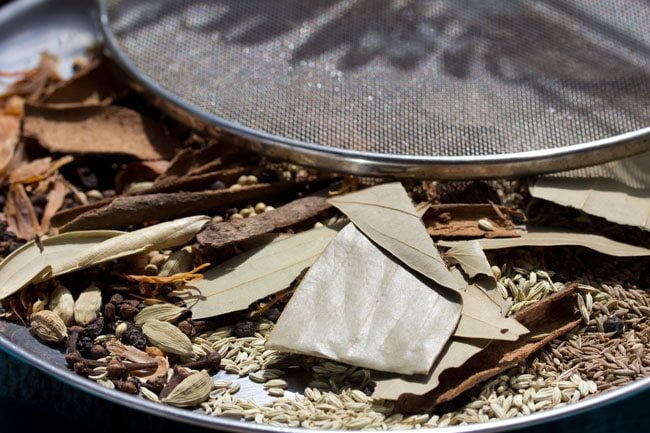
3. The photo below is of all the spices after being sun-dried for 2 days. As you can see, there is no trace of any moisture on the spices and they also become slightly crisp.
Like I have mentioned above, if you do not want to sun-dry, then roast each spice separately (except for ginger powder and rose petals) in a frying pan on a low heat until the spices are lightly toasted releasing their essential oils and becoming fragrant.
Remember to stir often when roasting or toasting the spices and do not burn them.
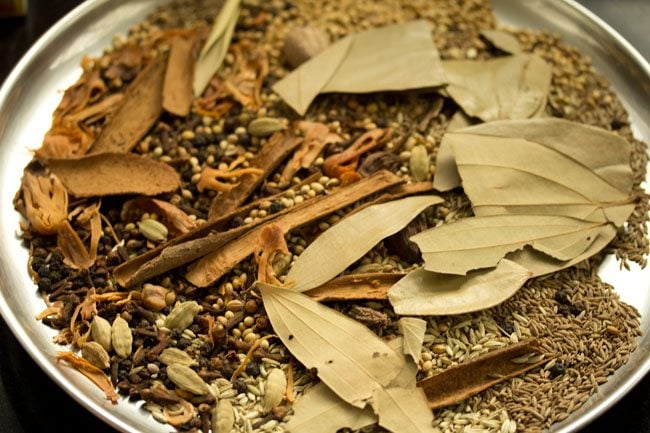
4. Before you begin grinding the whole spices, take the nutmeg in a mortar-pestle and crush it coarsely. Set aside.
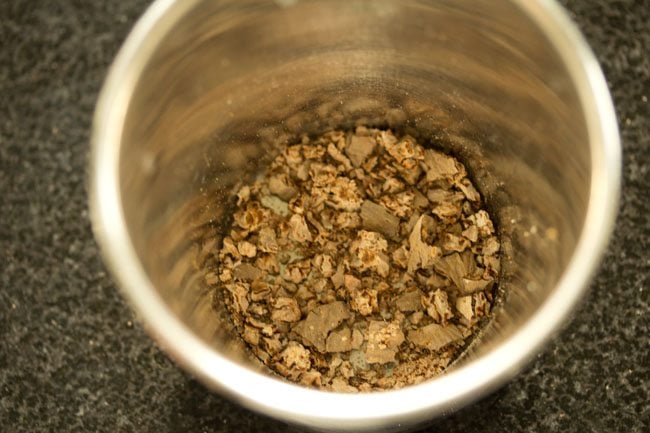
Make Garam Masala
5. Working in batches as needed, add all the whole spices in a dry grinder jar or coffee grinder or spice grinder. Add according to the capacity of the jar, breaking larger items like cinnamon sticks as needed to fit.
You also have to add whole green cardamom pods and black cardamom pods to the spice grinder or mixer-grinder. Do not remove their outer husks.
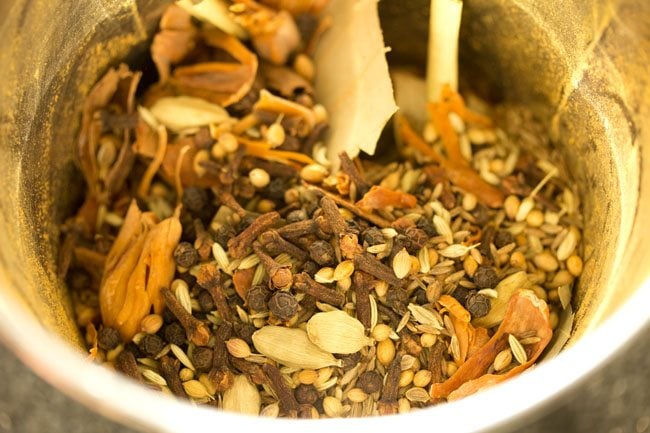
6. Then add the coarsely crushed nutmeg powder.
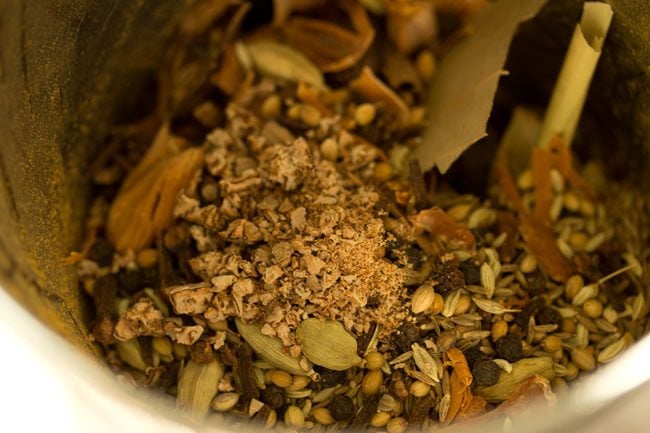
7. Next add 2 tablespoons ginger powder. You can skip ginger powder if you do not have it.
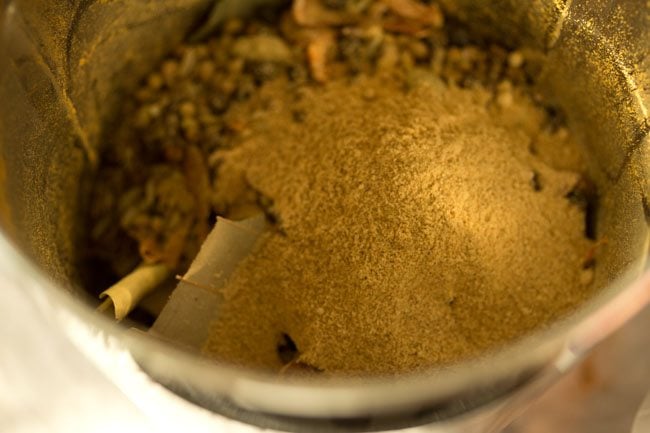
8. Grind to a smooth and fine powder.
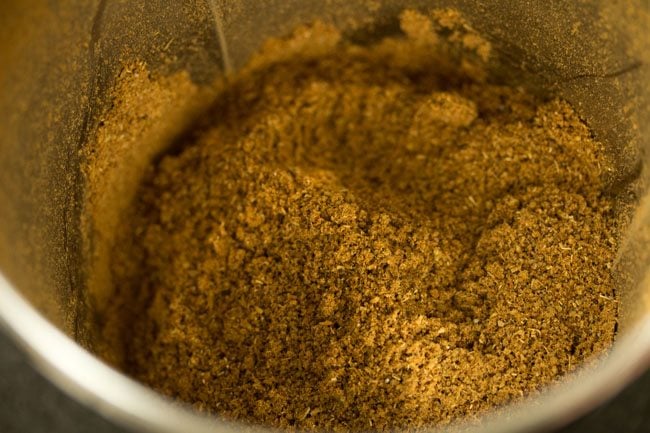
9. If using dried rose petals, then add them at this step.
Again I mention here that adding rose petals is optional and you can skip if you do not have.
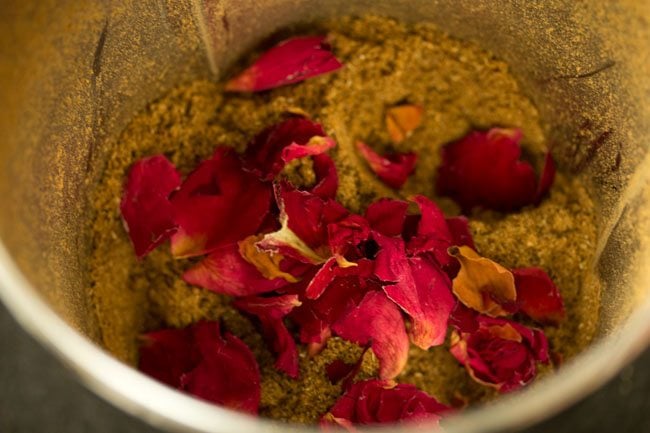
10. Grind again.
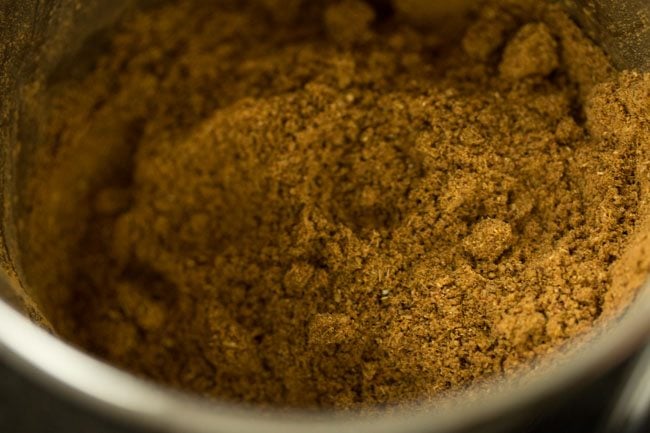
11. While this is optional, I recommend that you sift the powder and grind the tiny bits left on the sieve.
Let the powder cool down. You can spread it on a plate to cool it down more quickly, or allow it to cool in the grinder jar itself. Then spoon the powder in a clean glass jar.
NOTE: I ground all the masala at once. If grinding in batches, then remove the ground masala powder to a plate or bowl after each grinding. Be sure to mix all the resulting powder together very well with a spoon before storing in a jar.
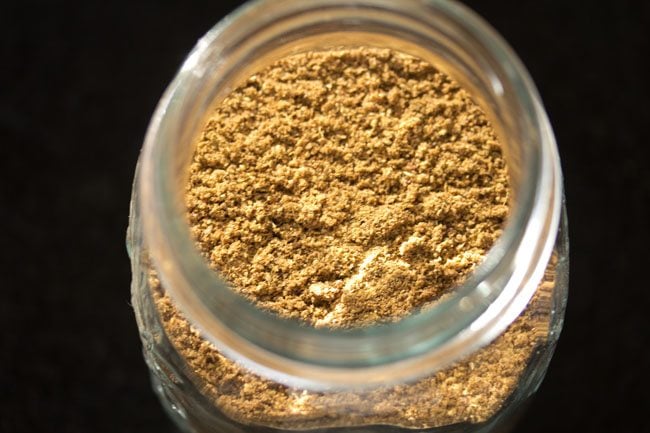
Storage
Cover tightly and keep in a cool dry place. You can also keep it in the fridge or freezer. This recipe yields about 190 grams of garam masala. Always store homemade garam masala in an air-tight jar in a cool dry place, using within 6 months for best results.
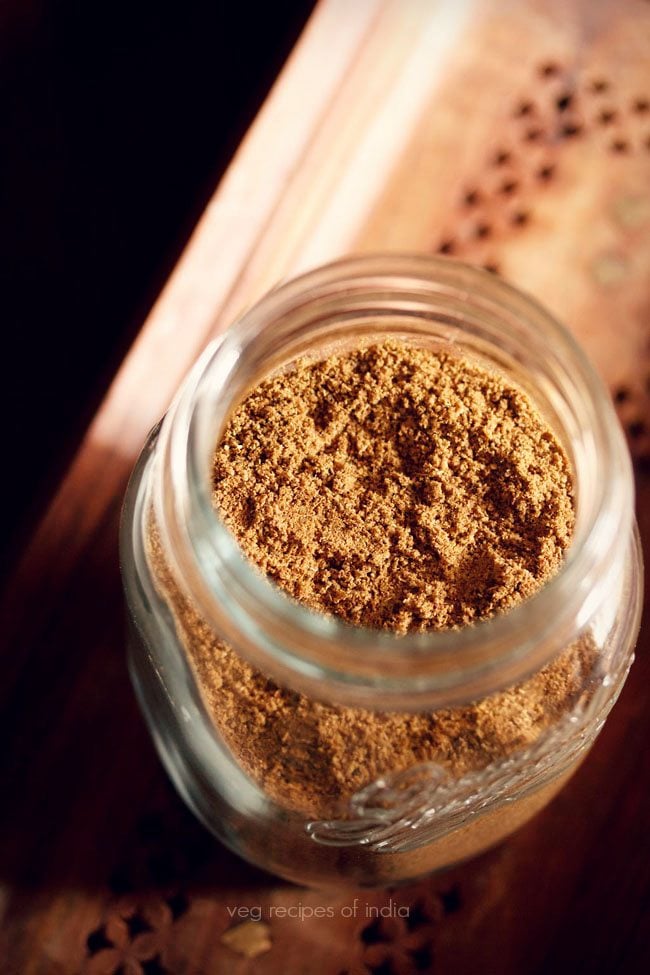
About Punjabi Garam Masala
This is an important Indian spice blend that is a must-have in every Punjabi home. Humble dal (lentils) or vegetable dishes (sabzi) are taken to another level when you add a bit of this fragrant spice blend.
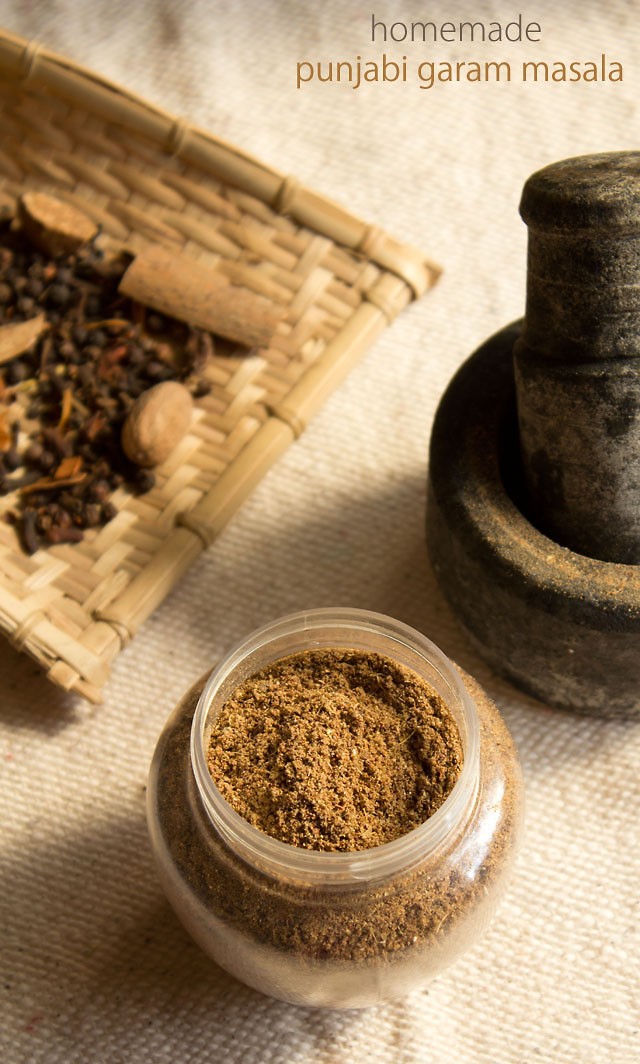
This flavorful masala is added in most Punjabi recipes, including Paneer Butter Masala, Kadai Paneer, Palak Paneer, Kadhi Pakora, Malai Kofta, Dum Aloo, and so on.
When we make this masala, we don’t roast or toast the spices. We just sun dry them and then powder the spices. If you prefer, you can lightly dry roast the spices instead of sun-drying them, but don’t roast the dry ginger.
I usually add somewhere between ¼ – ½ teaspoon of this Punjabi garam masala to for every 4 servings of the lentil, vegetable dishes or curries I make.
A picture below of the spices used for making the punjabi garam masala recipe.
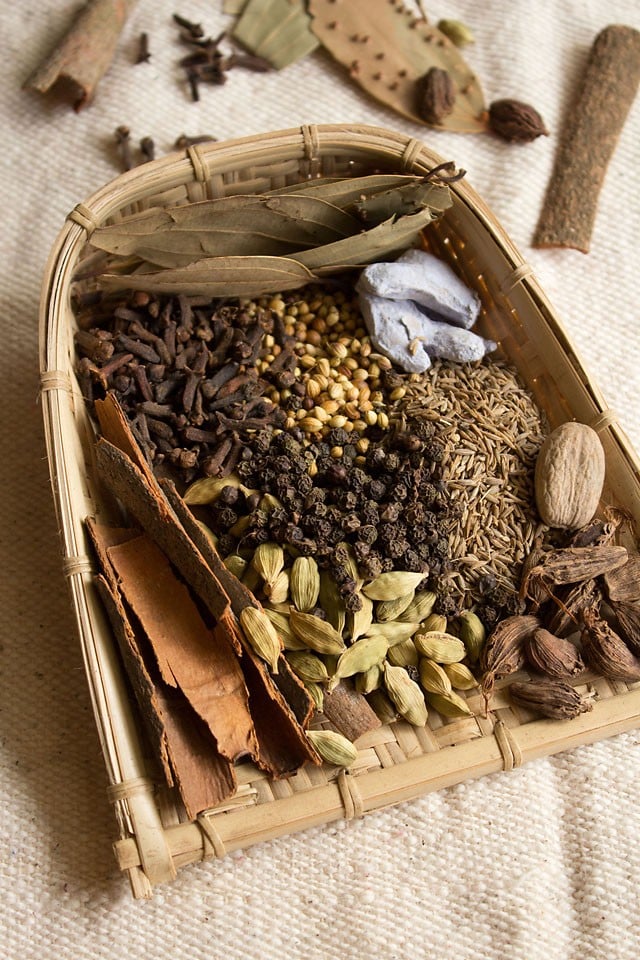
How to make Punjabi Garam Masala
Sun Dry Spices
1: Pick the cumin and coriander seeds for any stones. Spread the spices on a tray or a plate.
Keep the whole spices in sunlight for 2 – 3 days, turning over the spices occasionally to help them dry evenly in the sun.
While sun-drying, cover the spices with a muslin or a thin cotton napkin or a wire-meshed lid so as to prevent any dust from settling on the spices.
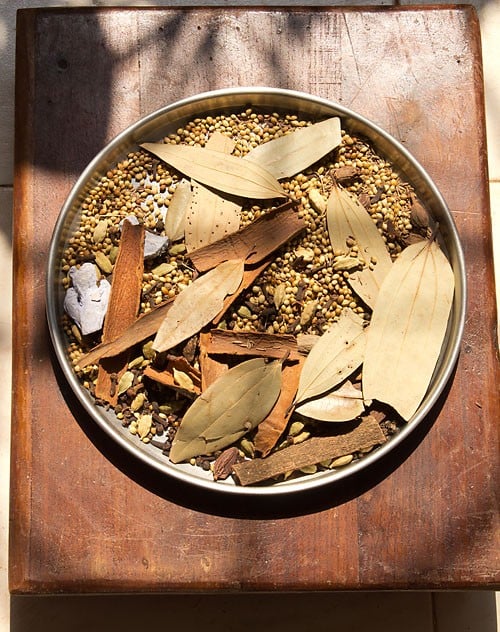
Grind Spices
2: In a very good dry grinder or coffee grinder, grind the dry ginger. Dry ginger (saunth) is the toughest to grind, so I always grind it first.
You can also use 2 tablespoons ground ginger powder instead of dry whole ginger. In the photo below, you can still see a small bit of dry ginger still left after grinding.
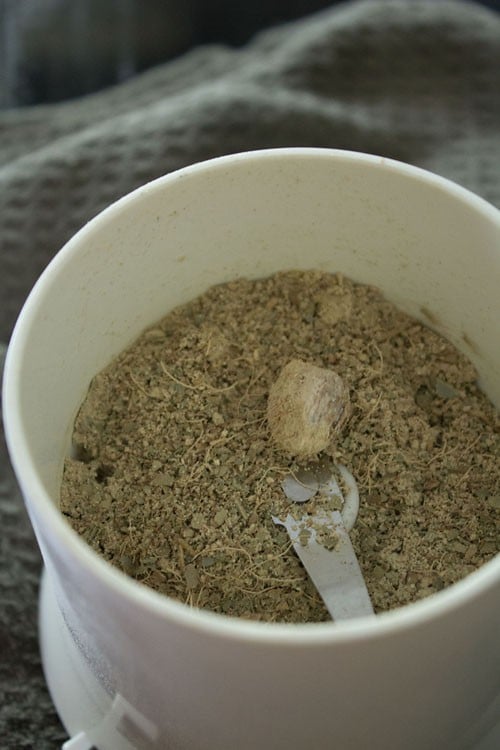
3: The next one to grind is the nutmeg. Next up are the cinnamon sticks and whole nutmeg.
The cinnamon sticks (dalchini) should be broken and added to the dry grinder. You can grate or break the nutmeg with a mortar before adding.
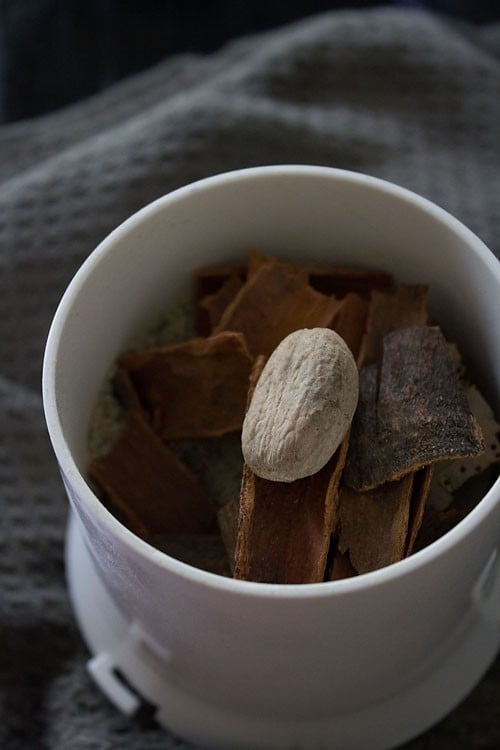
4: Grind these spices to a fine powder. Remove to a bowl.
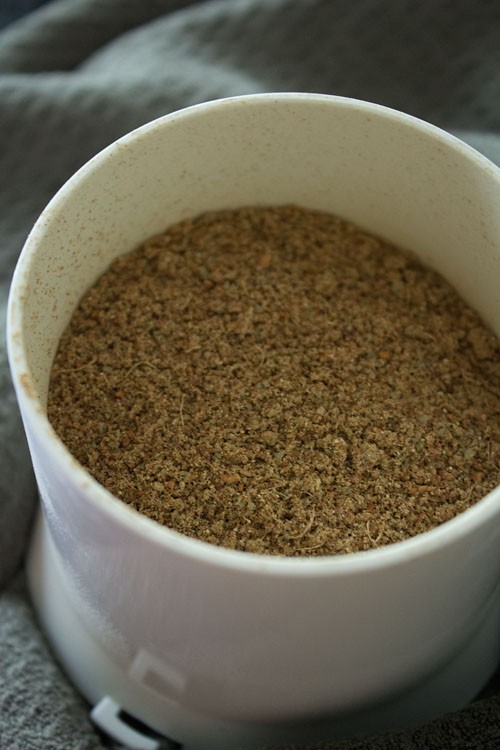
5: Add the rest of the spices to the dry grinder.
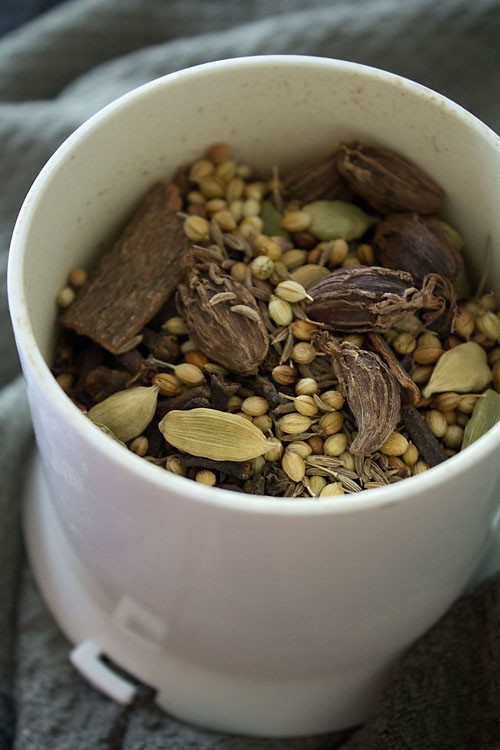
6: Grind to a fine powder.
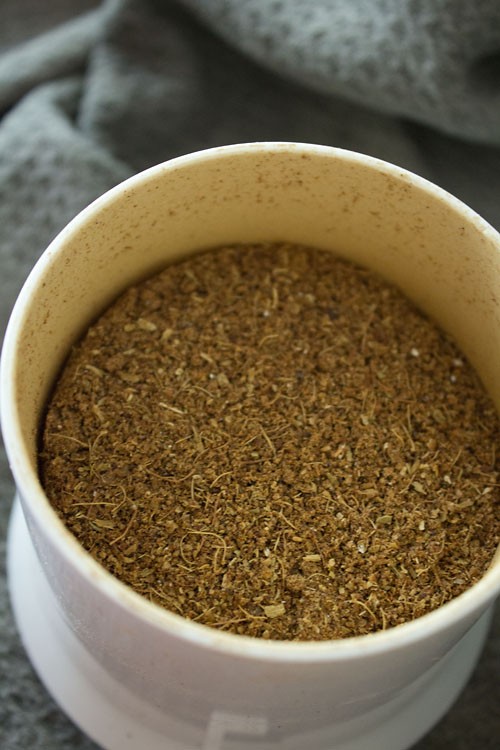
7: Add it to the bowl where the previously powdered dry ginger (saunth), nutmeg, Indian bay leaves (tejpatta) and cinnamon were kept. Mix very well.
If you have a powerful grinder, you can add all the spices at once and grind to a fine powder.
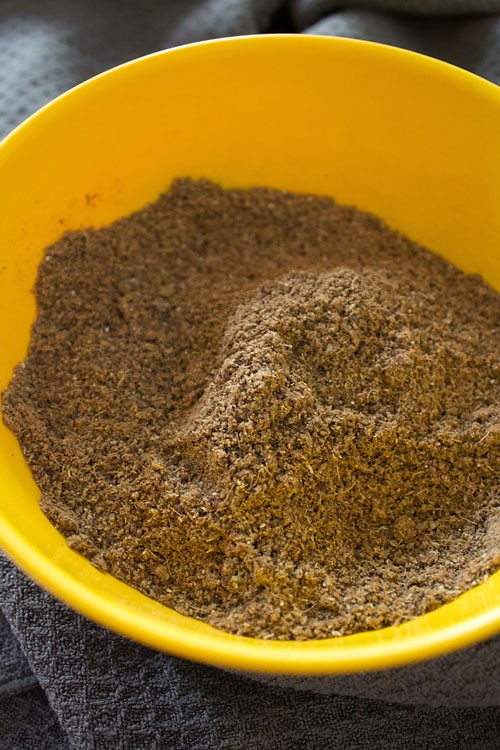
8: Store in an air-tight container in a cool dry place. It keeps well for about 6 months. You can add this spice blend to your everyday curries, lentils, veggies and rice dishes.
About ¼ to ½ teaspoon of this punjabi garam masala for 4 servings is enough to flavor up your curries and dals.
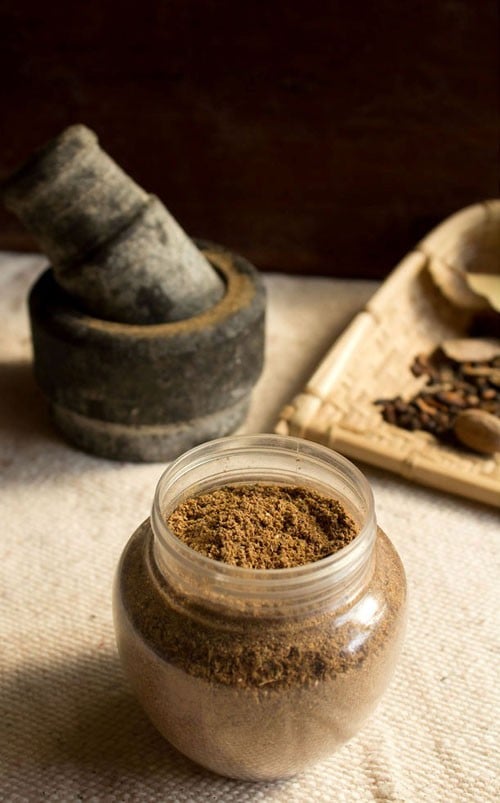
How to use Garam Masala Powder?
Just a small amount of this warm, complex spice blend is all that you need to liven up the dal, curries and veggie preparations that you make.
It is added in many popular Indian recipes like Samosa, Chana Masala, Paneer Lababdar, Bhindi Masala, Paneer Tikka Masala, among others – once you try it, you’ll want to add this homemade garam masala to just about everything!
Please note that it is always better to make smaller batches of homemade masala as the aroma wanes over time.
When and how much to add?
Garam masala can either be added during the cooking process or after the cooking is done. Follow the recipe that you make and add the same amount as mentioned in the recipe.
But do note that for 4 to 5 servings of any given recipe, about ¼ – ½ teaspoon of this garam masala is all you need; remember, the spice blend is very strong.
The old adage that “less is more” really rings true here. Avoid adding too much garam masala to your dishes, or you’ll risk the flavors being out of whack.
Adding a little does the work and beautifully harmonizes the flavors and fragrances of your meals.
Garam Masala vs Curry Powder
Garam masala is a completely different spice blend than curry powder. In fact, curry powder is not even an Indian invention, rather was the product of British traders during the early 18th century.
Funnily enough, most Indians are not even aware of what curry powder is, but any Indian homemaker will know about (and probably have a family recipe for) garam masala. That said, the original British recipe for curry powder does include some of the spices seen in garam masala.
Generally speaking, curry powder spice mixes have even more spices in them than garam masalas. Curry powder also has turmeric added to it, which gives it the signature yellow hue. Curry powder is mild with sweet notes, unlike garam masala which is highly fragrant and intense with spicy undertones.
Two Kinds
Broadly categorizing, there are two types of garam masala made.
1. Pakka Garam Masala – The Hindi word pakka means “cooked.” In this method, the spices are roasted until they become fragrant and release their essential oils. These roasted spices are then ground.
Most of the packaged garam masala are pakka versions. The ones which are regularly made in Indian homes are also pakka garam masala.
Since the spices are already cooked, It is always sprinkled on the food once it is cooked.
2. Kaccha garam masala – In this method, the spices are not roasted or “cooked,” but instead are sun-dried for a few days and then ground. Sun-drying draws any extra moisture from them making them lightly crisp.
The Hindi word kaccha literally means “raw.” This garam masala powder needs to be cooked for the spices to bring out their flavor and aroma. Because of this, kaccha garam masala is always added when the food is still being cooked.
The recipe that I have shared here is actually kaccha garam masala, but you can use the same proportions and make pakka garam masala by roasting the spices in a skillet or frying pan instead of sun-drying.
This information and knowledge on the two categories of this traditional spice mix comes from my family and my very long experience with Indian cooking.
Variations
As with most Indian recipes, there are regional variations for garam masala. The proportions and types of spices used are different. For example, the Punjabi Garam Masala recipe (which I have shared below) has more coriander seeds and fragrant spices than my classic, everyday garam masala discussed above.
This Punjabi garam masala is an heirloom passed down to me from my mother-in-Law. Every Punjabi home has their own versions of making this spice blend, and this one is a favorite in our home.
Other variations of garam masala recipe do not include coriander seeds, because coriander is a cooling spice and adding it reduces the heat in the masala. I add them in this recipe for aroma, flavor and to balance the heat.
FAQs
Generally speaking, storing spice blends in an airtight container in a cool and dark spot is usually enough to keep them for 6 months to a year. If you live in a humid environment, you may want to take the added precaution of storing your homemade masala in the refrigerator or freezer.
Ground spices should be used within six months of grinding for the best quality. I recommend making your own masalas rather than buying store bought, because you know that they are fresh.
If you want the masala to last longer, don’t grind it until you are ready to use it – whole spices will keep their essential oils longer, meaning they will taste more fresh and pungent.
The recipes I have shared here use only black peppercorns for their “heat.” As you move south through India, you’ll find spicier versions of this ubiquitous spiced blend. If you want to make yours hotter, try adding dry red chilis to the mix!
More Indian Spice Mixes
Please be sure to rate the recipe in the recipe card or leave a comment below if you have made it. For more vegetarian inspirations, Sign Up for my emails or follow me on Instagram, Youtube, Facebook, Pinterest or Twitter.
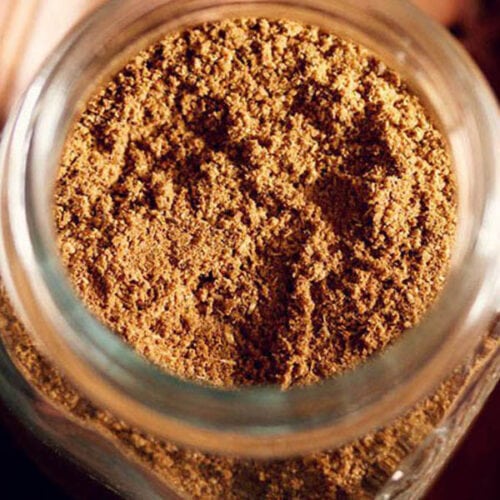
Garam Masala Recipe (Homemade and Authentic)
Ingredients
- ½ cup cumin seeds – 63 grams
- ¼ cup coriander seeds (dhania) – 18 grams
- ¼ cup fennel seeds (saunf) – 24 grams
- 2 tablespoons caraway seeds (shahi jeera) – 9 grams
- 2 tablespoons mace (javitri) – 8 grams
- 10 cinnamon sticks (dalchini) – each of about 2 to 3 inches, 7 grams
- 2 tablespoons cloves (lavang) – 12 grams
- 20 green cardamoms – 4 grams
- 6 black cardamoms – 4 grams
- 1 nutmeg (jaiphal)
- 10 tej patta (Indian bay leaf) – 2 grams
- 2 tablespoons dry ginger powder – ground ginger (saunth), optional
- 2 tablespoons black pepper – 20 grams
- 3 tablespoons dried rose petals (optional)
Instructions
- First take the whole spices one by one. Then check for stones, chaff or any hidden mold in them.
- Discard the stones, chaff or husks. If there are any insects or mold or fungi, then discard the spices. Don’t use them.
- Add the whole spices in a plate or tray. Keep the plate in the sun for 2 to 3 days.Instead of sun-drying, you can lightly roast/toast in a frying pan, all the whole spices until except for dry ginger powder (ground ginger) and rose petals.
- While being sun dried, cover with a wire-meshed lid or a muslin or loosely woven cotton napkin, so that dust does not fall on the spices, when they are being sun dried. During the day, I would keep the spices out. During night, I would keep the plate inside with a loose lid covering it.
- After getting sun dried, there is no trace of moisture in the spices and they also become slightly crisp.
- Before you begin, grinding the whole spices, take the nutmeg in a mortar-pestle and crush it coarsely. Keep aside.
- Now add all the whole spices in the dry grinder jar. Break the cinnamon, tej patta and then add. You can also use a coffee grinder. Add according to the capacity of the jar.
- Then add the coarsely crushed nutmeg powder.
- Next add 2 tablespoons ginger powder. If you plan to roast/toast the spices for making garam masala, then do not roast ginger powder.
- Grind to a smooth powder. You can grind in 1 or 2 batches.
- If using dried rose petals, then add them at this step. If you don’t have rose petals then skip adding them. Again grind.
- If you want, you can sift it and grind the tiny bits left on the sieve.
- Let the powder cool down. You can spread it in a plate or allow it to cool in the grinder jar itself. Then spoon the powder in a clean glass jar.
- Cover tightly and keep in a cool dry place. You can also keep it in the fridge or freezer. This recipe yields about 190 grams of garam masala.
Notes
Nutrition Info (Approximate Values)
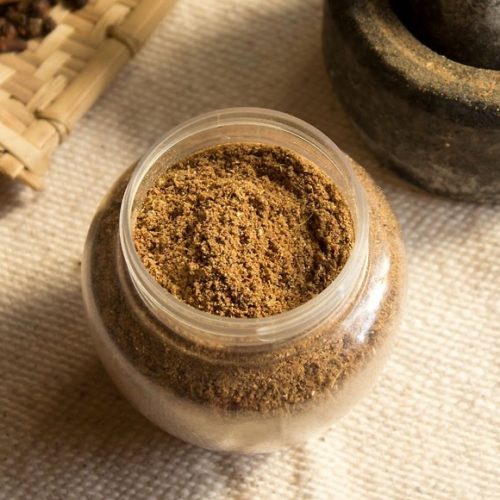
Punjabi Garam Masala
Ingredients
- ½ cup coriander seeds
- ¼ cup cumin seeds
- 9 pieces cinnamon – each stick having an approx size of about 2.5 to 3 inches
- 2 tablespoons cloves
- 10 tejpatta
- 10 black cardamoms
- 2 tablespoons green cardamoms
- 1.5 tablespoons black peppercorns
- 1 piece dry ginger about 1 inch or 2 tablespoons ground ginger powder
- 1 nutmeg
Instructions
- Pick the coriander and cumin seeds of stones.
- Spread the whole spices on a plate or thali.
- Keep in the sun for 2 to 3 days. Cover the spices with a thin muslin or a wire-meshed lid while sun-drying so that dust does not fall on them
- Grind the dry ginger first. If you do not have dry ginger swap with 2 tablespoons of pre-ground ginger powder. You do not need to sun dry ginger powder.
- Then add the broken cinnamon sticks and nutmeg.
- Grind to a fine powder and keep aside.
- Now add the rest of the spices and grind to fine powder.
- Mix both the spice powder batches well.
- Store punjabi garam masala in an air-tight container or jar.
- You can also refrigerate or freeze this spice blend.
Notes
Nutrition Info (Approximate Values)
This garam masala recipe post from the archives, first published in June 2016 has been republished and updated on 30 December 2021.
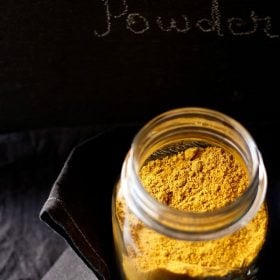
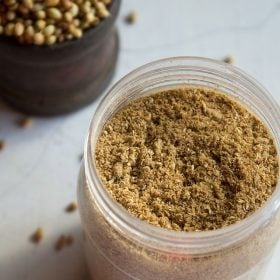
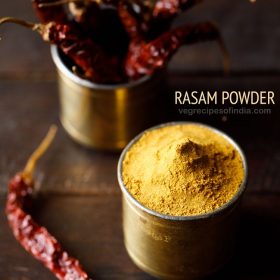
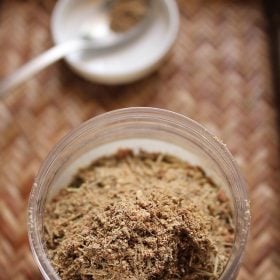








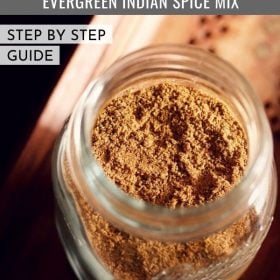
Ekdam sahi,i like it,i tried it also,its best
Thnks
Welcome and thanks for the feedback.